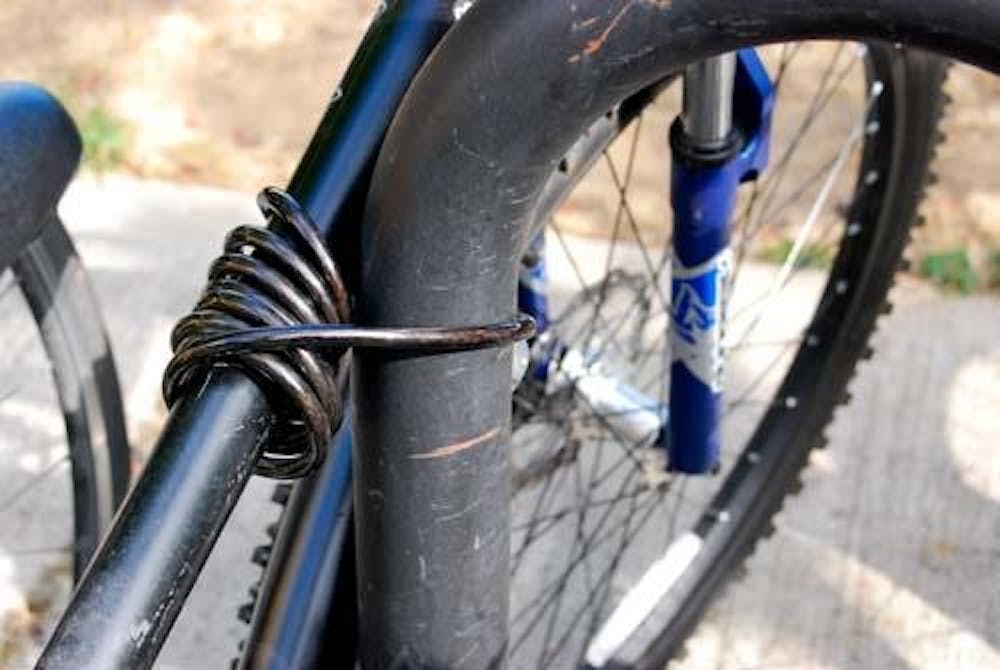Public Saftey has received reports of five stolen bikes since the start of the semester
(Jackie Jeffers | The Beacon)
By Amanda Blas, Staff Writer blas13@up.edu
College campuses may be great places to ride bikes, but they can also be risky places for bikes owners.
According to a study conducted by Integrated Cycle Systems, a four year college student has a 53 percent chance of having his or her bike stolen.
UP students are no exception.
"We've had five bikes stolen on campus since around the start of the semester in late August," Director of Public Safety Gerald Gregg said.
Last year, UP faced similar problems with bike theft at the beginning of the semester, leading to a 5 percent increase in bike thefts from the previous year.
According to Gregg, Public Safety does not have information on this year in relation to last academic year.
"We'll do everything we can to deter the bike thefts," Gregg said. "Our hope is to see a decrease in bike theft."
According to Gregg, thefts increase at the start of the year.
"This is a prime opportunity," Gregg said. "There's a bunch of new students bringing in new bikes."
Sophomore Joe Shorma had his bike stolen the first week of school, despite having locked it. He said the timing of the bike theft made the experience worse for him.
"I was extremely disappointed about losing my bike especially because it was the first week of school," Shorma said.
Shorma had reported his bike stolen last week from in front of Schoenfeldt Hall.
According to Gregg, most of the stolen bikes have been taken from the bike racks in front of the dorms.
This year, UP also faces the problem of wheels being stolen off of bikes.
"On more expensive bikes, people are willing to steal its components," Gregg said.
Junior Devin Helmgren had his bike locked up at one of the Haggerty bike racks overnight when the wheels from his bike were taken.
"I locked it up in a well-lit area that was visible from the road and from P-Safe," Helmgren said. "I went to bed, and when I got up the next morning to ride my bike, the wheels were gone."
While most of the thefts have occurred close to student housing, Gregg does not think students are to blame.
"I suspect that somebody comes to campus considering this and looking around for bikes to steal and lift," Gregg said.
According to Gregg, Public Safety officers will be paying close attention to the bike racks. However, he still encourages students to keep an eye out.
"If students see anyone suspicious hanging around the bike racks or witness any bikes being stolen, they should call Public Safety," Gregg said.
In addition, there are several precautions students can take to help prevent their bikes from being stolen.
"We encourage the students to bring their bikes to the Public Safety office to be registered," Gregg said.
By registering their bikes, students are given an identifying sticker to put on their bikes, which matches Public Safety records that include a description of the bike, the student's name and their contact number.
According to Gregg, this can help Public Safety track down the bike or identify it if it is recovered.
Gregg's best suggestion for students is to make sure they always lock their bikes with a high quality lock.
"A bike lock is cheap insurance," Gregg said.
Shorma agrees.
"If people want something, like a bike, they will do anything in their power to get what they want," Shorma said. "But there are always ways to prevent it, like a better lock."
According to Gregg, students' best bet is the u-lock combined with a cable lock, which is sold at the Public Safety Office for 23 dollars.
"You put the u-lock around the frame and the pole of the bike rack and the cable can run through both tires," Gregg said. "These are very heavy construction and they're pretty significant in terms of strength."
This combination of two locks can enhance bike protection.
"It makes it really hard for a bike thief to navigate two bike lock systems," Public Safety officer Sgt. Michael Kranyak said. "It also takes a lot of time, and a guy who's going to pick a target isn't going to want to be around a bike any more than he has to."
Because the u-lock and cable are two lock systems put together, it is not the most convenient.
"It's a little more to carry, but it's worth it," Helmgren said.
Finally, Gregg advises students to report their stolen bikes to the Portland Police Bureau.
"We ask the students to do this if their bike is stolen so they can get into not only our system, but the Portland Police Bureau's system as well," Gregg said.
Lock it up, UP!
U-locks, also called D-locks, are the most effective bike locking devices because they are constructed to withstand multiple forms of lock cutting. Because U-locks closely lock to the frame of the bike and a bike rack, they do not offer any wheel protection.
Chain locks secure bikes by locking the bike's wheels and frame to a bike rack with a chain. While the chain's weight, length, and link size all affect bike protection, chain locks can be cut to release the bike. These locks are also hard to lock, which makes it inconvenient.
Cable locks consist of a cable permanently attached to a lock. Similar to chain locks, they are meant to lock the entire bike to the bike rack. Lighter than most other bike locks, they are the most convenient, but offer no real protection because they can be easily cut with bolt cutters
-Amanda Blas
Most risky (Jackie Jeffers)
Less Risky (Jackie Jeffers | The Beacon)
Best Option (Jackie Jeffers | The Beacon)








